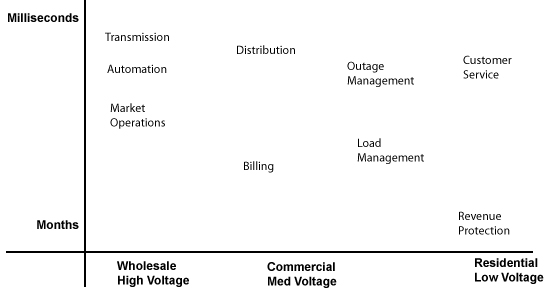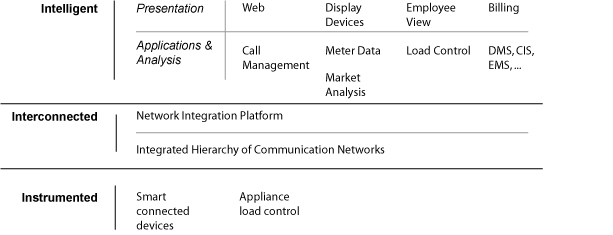Smart Grid: Working with Utilities and Big Tech
Notes from Pillsbury Winthrop Forum 30 July 2009.
- Michael Murphy – Pillsbury Winthrop (Moderator)
- Stephen Callahan – IBM Energy & Utilities
- Gerd Goette – Siemens Venture Capital
- Eve Schooler – Intel Labs
- Michael Hindus – Pillsbury Winthrop Energy Law
- Erfan Ibrahim – Electric Power Research Institute EPRI
Introductions. Approximate areas of interest.
- Michael Murphy (Pillsbury): Moderator
- Stephen Callahan (IBM): Americas Smart Grid. Partners Progress Energy (generation), Pepco (customer service), Centerpoint (network), Sempra (microgrid)
- Gerd Goette (Siemens): Strategic and financial. VC to incorporate technology including Smart Grid, clean coal, transport.
- Eve Schooler (Intel): Realtime measurement and communication.
- Michael Hindus (Pillsbury): Regulatory law, transactional and acquisition law.
- Erfan Ibrahim (EPRI) : Utility utilization of smart meter data.
Comments: Stephen Callahan (IBM)
IBM Energy and Utilities Initiatives
- Intelligent transportation ("Green" is a driver: carbon footprint, measurement)
- Carbon management
- Energy efficiency
- Intelligent utility networks
- Advanced water management (smart water; possibly a bigger problem than energy)
Smart Grid Time and Data Domains

Data management issues: exponentially more data due to smart meter endpoints, data residing in different places, data in different states, latency. IBM figure had more points, I took note of a representative sample.
Smart Grid structured into 3 layered components

Note: IBM figure showed many more entries, I took note of a representative sample showing layer functionality.
Comments: Gerd Goette (Siemens VC)
What do investors look for?
- There is a business case to replace meter readers.
- Reduction of carbon. This is not necessarily good for a business or utility who make money selling energy. However, regulators can affect business cases with rates, since it may not be the investor who is the beneficiary. So the business case is in the regulatory Policy.
Comments: Michael Hindus (Pillsbury)
Legal aspects of demand reduction.
- Utility return is only on the Rate base. They won't invest unless there is a rate-based return.
- So regulatory policy has to make this return.
- Operational savings
- Outage remediation
- Smart Grid not only deals with end user energy management, it also deals with Grid management.
- Two-way communications enables peak shifting.
Comments: Eve Schooler (Intel)
Utilities are burdened by "antiquated" technology
- Design gap defines the opportunity for companies.
- Energy Storage: in the network, and safe/non-threatening storage in the home
- Bandwidth: Network doesn't scale to handle the exponential increase of data in Smart Grid. Also, control must be decentralized.
- Connectivity, and correlation.
Comments: Erfan Ibrahim (EPRI)
Deployment Hurdles
- Open architectures are very important, but VC funding is going into proprietary offerings.
- Smart Grid will be like Health Care: many parties have to agree on the architecture.
- Open standards will be key.
- Maxwell's equations will limit wireless interconnect (home networks) in dense environments.
- Opportunities
- How to transmit past a transformer, using power-line carrier (i.e., eliminate wireless network)
- Security and intrusion detection
- Utilities can build a business case on operational efficiency up to the house. Then a home-services company can service the home, un-restricted by regulatory concerns.
- Utilities will retreat from home management.
- Schooler: people won't want to tinker, there's an opportunity for equipment to self-configure.
Moderator: What is the risk of regulatory over-reach?
- Callahan: Regulatory policy has fiduciary responsibility to ensure demand-response, and to get return by setting Rate.
- Goette: There are privacy and control issues.
- Hindus: To shift usage off-peak, users will pay a lot more. Utilities can incent users to shift in order to avoid massive capital required to handle peak load, but have to set rates substantially higher (10x - 15x peak rate) to do so.
- Goette: Off-peak shift can be handled like the Net: Sign up for a guaranteed "minimum bandwidth provision", beyond that it's "best efforts".
- Ibrahim: In California, in 5-7 years peak usage will exceed capacity we we'll be subject to brownouts/blackouts. We're now rushing to put immature technology into homes driven by regulatory mandate.
- Ibrahim: In the period 2030-2040 we face a sourcing problem. Smart Grid buys time until we can install nuclear. Wind and solar are to small a factor to get us there. Central power scheme is limited.
- Callahan: We'll have to change generation models to more distributed/residential solar and wind. (Site Note: However, reference to EIA Usage, shows that residential accounts for 25% of total usage.)
- Schooler: DOE security requirements effective Dec 2008. Need distributed architecture. Advocated aggregated home data, not sharing detailed home data to the network due to data-mining security issues. Keep your "health" info private, prevent knowledge of whether you're home or not. Distinguish between public and private data.
- Hindus: Distinction among data types. Utilities have commercial data already, for billing. It's well-protected. Need to prevent hacking into the grid, ensure data privacy.
- Ibrahim: grid control information must be sacred, not public. This will include usage at the meter, because it-s billing-related.
Moderator: Who are the buyers?
- Goette: Utilities, both regulated and un-regulated. Regulatory mandates, with rate-case for capital driven by the regulator. Un-regulated use driven by ROI.
- Hindus
- $3.4B in the Recovery Act, toward Utilities and Meter companies.
- Very significant: DOE issued guidelines today (30 July) on loan guarantees of $30B for Smart Grid, Storage, Generation, Manufacturing, and Transmission.
- Tax incentives grant 30% of facility costs.
- ARPA-E is funding $150M of new technology development.
- The State [of California] is funding CEC, RESCO.
- Callahan
- Regulatory agency drives business case: rate case is set to support capital investment.
- California mandates 30% renewable sources by 2020, sets up potential conflict between State vs. Federal law.
- Europe is ahead of the US in renewable deployment, average energy use is less.
- Ibrahim: Need to connect power usage to water because frequently big power users are pumping water. For example, residential use, can't turn on all the dishwashers simultaneously.
Moderator: What does it take to win?
- Schooler: Less regulatory issues. The side of the smart meter on the un-regulated side is less encumbered.
- Ibrahim: Technology should be agnostic on advantage to Utility or customer.
- Each venture is just a piece of the whole, must fit into the mosaic.
- Patience. It will be slow but is a huge market.
- Scalable, secure management. Fit in the big picture business model.
- Callahan: Shrewd segmentation, customer vs. Utility. Smart Grid will be an integration of the power world, with the Information world.
Questions and Comments from the Audience
- Q: 50% of electricity is not used. Isn't that a large potential savings? A: That number is a headline, but actually is in the physics of thermal conversion, line losses (7%). But there is study of staying in DC (home users) to save conversion.
- Re distributed generation: Reliability is not the same as redundancy.
- Need definition of smart appliances, recognizing the effect on consumers. Waxman-Markey (Cap & Trade bill) mandates, but needs definition.
- An early target for Smart Grid should be commercial/industrial, not so much residential. ROI favors commercial, and investors will favor deals with clear ROI.
- Q: How does Smart Grid integrate with mobile hybrid transportation? If everyone charges simultaneously that would kill the grid. A: Interactions are not yet well thought-out. We'll need 2-way negotiated use.
